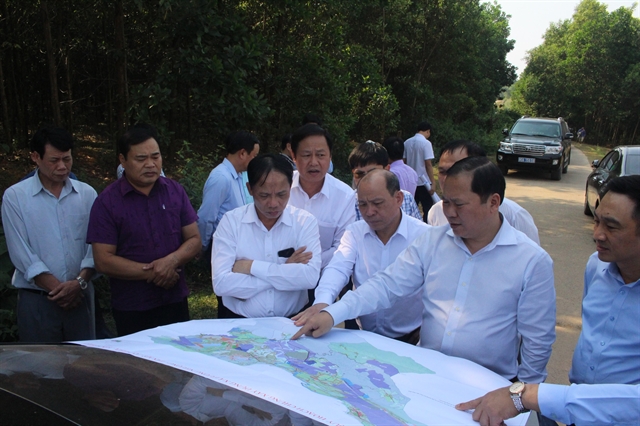 Society
Society

As a mountainous province at the gateway to the Northwest, Hòa Bình is an intermediate buffer zone connecting the Northern Delta with the high mountains of Northwest Việt Nam. Therefore, the province has an important position not only in terms of geography but also in influence on regional development.
Chairman of the People's Committee of Hòa Bình Province Bùi Văn Khánh spoke to Việt Nam News about the development plans of this mountainous province.
Could you tell us about the overall development goals for Hòa Bình Province in the next decade?
After the Provincial Planning Task was approved by the Prime Minister in June 2020, in April 2021, the Province established a Steering Committee for the formulation of provincial planning for the 2021 - 2030 period, with a vision to 2050.
Hòa Bình is completing the provincial planning report to submit to the Provincial Planning Appraisal Council, which sets out the overall objectives. That is Hòa Bình will be among the provinces with a good average income in the country, in the leading group of the Northern Midlands and mountains.
 |
| Chairman of the People's Committee of Hòa Bình province Bùi Văn Khánh (third from left) visits an industrial park. Photo courtesy of Hòa Bình Provincial Portal |
The province's economy will be developed based on science, technology and innovation, taking industry as the driving force, tourism as the spearhead, commodity-producing agriculture and high-tech as the basis, and associated with the province's synchronous and modern transport infrastructure system along with smart and green urban system.
The key objective of economic development is to improve people's material and spiritual life, maintain and promote traditional cultural identity, and ensure strong national defence and security.
So what is the “leverage” needed for the province to achieve these key goals?
The province chooses a scenario of fast and efficient development (average growth rate of 2021-2030 reaches 9 per cent) with four core pillars of processing, higher value manufacturing, agribusiness, tourism and satellite housing development.
The creation and development of dynamic product industries such as electrical industry and mechanical manufacturing, electrical equipment; agro-forestry-fishery processing industry; ecotourism, convalescence, sports tourism, cultural and historical tourism; high-tech agriculture and high-quality clean food products are the top tasks set by the province.
At the same time, the province focuses on developing dynamic economic zones in the key areas of Hòa Bình City and Lương Sơn District so that they become the leading localities and have the ability to spread to other districts.
We will also make efforts to well solve the economic linkage as the centre of internal connection between Hà Nội and the Northwest region. With its position as the gateway connecting the capital with the Northwest region, Hòa Bình is suitable for developing tourism, transportation, logistics, and economic links with Hà Nội and the Northwest region for production and exchange, agricultural products, industry and trade services.
In addition, Hòa Bình is determined to promote the development of digital government, digital economy and digital society; develop an enterprise system strong enough to enhance competitiveness in dynamic product industries; and improve people's quality of life and living environment from the fruits of economic development.
For economic development, what solutions does the province have to improve the investment environment? What are the potentials and strengths of the province to attract capital?
To attract capital, Hòa Bình has identified four core growth pillars in the 2021-2030 planning period, in which tourism is the spearhead.
Regarding agriculture, the province determines to develop in the direction of "organic and high-quality" production with centralisation of organic agricultural production, higher quality agricultural chains, commercial carbon sinks and agricultural tourism.
The higher value processing and manufacturing industry has the opportunity to become an important growth engine for Hòa Bình with the higher value wood processing industry, expanding the value chain of the electronics manufacturing industry, manufacturing hubs, high-end interior design as well as a potential sustainable building materials R&D centre.
These core growth pillars are supported by three development principles – focus on improving the digital economy, digital society and digital government with transformative infrastructure and innovative applications; apply modern and effective development options to conserve natural landscapes, resources and protect the environment, while creating conditions for long-term growth; and paying attention to the interests of ethnic minorities and mountainous people to ensure equality and social harmony.
We hope to receive positive evaluations from businesses and investors about the investment environment of the province.
Currently, Hòa Bình has a draft of the Strategic Environmental Assessment Report. What plans does the province have to promote economic development while ensuring environmental protection and sustainable development?
To fulfil the goals of environmental protection and sustainable development, by 2030, we strive to have the annual forest cover rate at over 51.5 per cent; 100 per cent of the urban population use clean water; 100 per cent of the rural population using hygienic water; 100 per cent of hazardous waste is safely disposed of according to official procedures; 90 per cent of rural solid waste is collected and treated; 100 per cent of industrial zones and clusters have a centralised wastewater treatment system that meets environmental standards; 100 per cent of investment projects meet requirements on environmental protection; and 95 per cent of municipal solid waste is collected and treated. VNS




